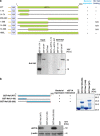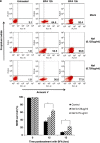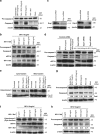Inhibition of ER stress-mediated apoptosis in macrophages by nuclear-cytoplasmic relocalization of eEF1A by the HIV-1 Nef protein
- PMID: 22476100
- PMCID: PMC3358010
- DOI: 10.1038/cddis.2012.32
Inhibition of ER stress-mediated apoptosis in macrophages by nuclear-cytoplasmic relocalization of eEF1A by the HIV-1 Nef protein
Retraction in
-
Inhibition of ER stress-mediated apoptosis in macrophages by nuclear-cytoplasmic relocalization of eEF1A by the HIV-1 Nef protein.Cell Death Dis. 2012 Aug 9;3(8):e368. doi: 10.1038/cddis.2012.104. Cell Death Dis. 2012. PMID: 22875005 Free PMC article. No abstract available.
Abstract
HIV-1 Nef protein has key roles at almost all stages of the viral life cycle. We assessed the role of the Nef/eEF1A (eukaryotic translation elongation factor 1-alpha) complex in nucleocytoplasmic shuttling in primary human macrophages. Nuclear retention experiments and inhibition of the exportin-t (Exp-t) pathway suggested that cytoplasmic relocalization of eEF1A, mediated by Exp-t, occurs in Nef-treated monocyte-derived macrophages (MDMs). We observed the presence of tRNA in the Nef/eEF1A complexes. Nucleocytoplasmic relocalization of the Nef/eEF1A complexes prevented stress-induced apoptosis of MDMs treated with brefeldin-A. Blockade of stress-induced apoptosis of MDMs treated with HIV-1 Nef resulted from enhanced nucleocytoplasmic transport of eEF1A with decreased release of mitochondrial cytochrome c, and from increased tRNA binding to cytochrome c, ultimately leading to an inhibition of caspase activation. Our results indicate that HIV-1 Nef, through the nucleocytoplasmic relocalization of eEF1A and tRNAs, enhances resistance to stress-induced apoptosis in primary human macrophages.
Figures










Similar articles
-
Blockade of BFA-mediated apoptosis in macrophages by the HIV-1 Nef protein.Cell Death Dis. 2014 Feb 20;5(2):e1080. doi: 10.1038/cddis.2014.16. Cell Death Dis. 2014. PMID: 24556695 Free PMC article.
-
HIV-1 Nef impairs key functional activities in human macrophages through CD36 downregulation.PLoS One. 2014 Apr 4;9(4):e93699. doi: 10.1371/journal.pone.0093699. eCollection 2014. PLoS One. 2014. PMID: 24705461 Free PMC article.
-
HIV-1 Nef interacts with HCV Core, recruits TRAF2, TRAF5 and TRAF6, and stimulates HIV-1 replication in macrophages.J Innate Immun. 2013;5(6):639-56. doi: 10.1159/000350517. Epub 2013 Jun 13. J Innate Immun. 2013. PMID: 23774506 Free PMC article.
-
tRNA and cytochrome c in cell death and beyond.Cell Cycle. 2010 Aug 1;9(15):2936-9. doi: 10.4161/cc.9.15.12316. Epub 2010 Aug 7. Cell Cycle. 2010. PMID: 20676046 Free PMC article. Review.
-
The many roles of the eukaryotic elongation factor 1 complex.Wiley Interdiscip Rev RNA. 2012 Jul-Aug;3(4):543-55. doi: 10.1002/wrna.1118. Epub 2012 May 3. Wiley Interdiscip Rev RNA. 2012. PMID: 22555874 Free PMC article. Review.
Cited by
-
The unexpected roles of eukaryotic translation elongation factors in RNA virus replication and pathogenesis.Microbiol Mol Biol Rev. 2013 Jun;77(2):253-66. doi: 10.1128/MMBR.00059-12. Microbiol Mol Biol Rev. 2013. PMID: 23699257 Free PMC article. Review.
-
Mucosal immunity and tRNA, tRF, and tiRNA.J Mol Med (Berl). 2021 Jan;99(1):47-56. doi: 10.1007/s00109-020-02008-4. Epub 2020 Nov 16. J Mol Med (Berl). 2021. PMID: 33200232 Review.
-
Role of fatty-acid synthesis in dendritic cell generation and function.J Immunol. 2013 May 1;190(9):4640-9. doi: 10.4049/jimmunol.1202312. Epub 2013 Mar 27. J Immunol. 2013. PMID: 23536633 Free PMC article.
-
HIV-1 replication and the cellular eukaryotic translation apparatus.Viruses. 2015 Jan 19;7(1):199-218. doi: 10.3390/v7010199. Viruses. 2015. PMID: 25606970 Free PMC article. Review.
-
Cellular unfolded protein response against viruses used in gene therapy.Front Microbiol. 2014 May 26;5:250. doi: 10.3389/fmicb.2014.00250. eCollection 2014. Front Microbiol. 2014. PMID: 24904562 Free PMC article. Review.
References
-
- Walter P, Ron D. The unfolded protein response: from stress pathway to homeostatic regulation. Science. 2011;334:1081–1086. - PubMed
-
- Masutani H, Ueda S, Yodoi J. The thioredoxin system in retroviral infection and apoptosis. Cell Death Diff. 2005;12:991–998. - PubMed
-
- Uhm HD, Orenstein JM, Wahl SM. Fas mediates apoptosis in human monocytes by a reactive oxygen intermediate dependent pathway. J Immunol. 1996;156:3469–3477. - PubMed
Publication types
MeSH terms
Substances
LinkOut - more resources
Full Text Sources
Miscellaneous

